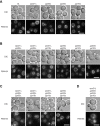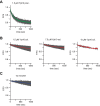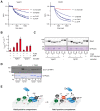A conserved and regulated mechanism drives endosomal Rab transition
- PMID: 32391792
- PMCID: PMC7239660
- DOI: 10.7554/eLife.56090
A conserved and regulated mechanism drives endosomal Rab transition
Abstract
Endosomes and lysosomes harbor Rab5 and Rab7 on their surface as key proteins involved in their identity, biogenesis, and fusion. Rab activation requires a guanine nucleotide exchange factor (GEF), which is Mon1-Ccz1 for Rab7. During endosome maturation, Rab5 is replaced by Rab7, though the underlying mechanism remains poorly understood. Here, we identify the molecular determinants for Rab conversion in vivo and in vitro, and reconstitute Rab7 activation with yeast and metazoan proteins. We show (i) that Mon1-Ccz1 is an effector of Rab5, (ii) that membrane-bound Rab5 is the key factor to directly promote Mon1-Ccz1 dependent Rab7 activation and Rab7-dependent membrane fusion, and (iii) that this process is regulated in yeast by the casein kinase Yck3, which phosphorylates Mon1 and blocks Rab5 binding. Our study thus uncovers the minimal feed-forward machinery of the endosomal Rab cascade and a novel regulatory mechanism controlling this pathway.
Keywords: D. melanogaster; GEF; Mon1-Ccz1; Rab cascade; Rab5; Rab7; S. cerevisiae; biochemistry; cell biology; chemical biology; endosome.
© 2020, Langemeyer et al.
Conflict of interest statement
LL, AB, EH, NF, YH, AP, KA, DK, CU No competing interests declared
Figures















Similar articles
-
Dynamic association of the PI3P-interacting Mon1-Ccz1 GEF with vacuoles is controlled through its phosphorylation by the type 1 casein kinase Yck3.Mol Biol Cell. 2014 May;25(10):1608-19. doi: 10.1091/mbc.E13-08-0460. Epub 2014 Mar 12. Mol Biol Cell. 2014. PMID: 24623720 Free PMC article.
-
Regulatory sites in the Mon1-Ccz1 complex control Rab5 to Rab7 transition and endosome maturation.Proc Natl Acad Sci U S A. 2023 Jul 25;120(30):e2303750120. doi: 10.1073/pnas.2303750120. Epub 2023 Jul 18. Proc Natl Acad Sci U S A. 2023. PMID: 37463208 Free PMC article.
-
The Ccz1-Mon1-Rab7 module and Rab5 control distinct steps of autophagy.Mol Biol Cell. 2016 Oct 15;27(20):3132-3142. doi: 10.1091/mbc.E16-03-0205. Epub 2016 Aug 24. Mol Biol Cell. 2016. PMID: 27559127 Free PMC article.
-
Who's in control? Principles of Rab GTPase activation in endolysosomal membrane trafficking and beyond.J Cell Biol. 2021 Sep 6;220(9):e202105120. doi: 10.1083/jcb.202105120. Epub 2021 Aug 12. J Cell Biol. 2021. PMID: 34383013 Free PMC article. Review.
-
Membrane dynamics and fusion at late endosomes and vacuoles--Rab regulation, multisubunit tethering complexes and SNAREs.Eur J Cell Biol. 2011 Sep;90(9):779-85. doi: 10.1016/j.ejcb.2011.04.007. Epub 2011 Jun 16. Eur J Cell Biol. 2011. PMID: 21683469 Review.
Cited by
-
Class III phosphatidylinositol 3-kinase complex I subunit NRBF2/Atg38 - from cell and structural biology to health and disease.Autophagy. 2021 Dec;17(12):3897-3907. doi: 10.1080/15548627.2021.1872240. Epub 2021 Jan 18. Autophagy. 2021. PMID: 33459128 Free PMC article. Review.
-
ESCRTing the RABs through conversion.Biochem Soc Trans. 2025 Apr 30;53(2):431-445. doi: 10.1042/BST20253007. Biochem Soc Trans. 2025. PMID: 40605338 Free PMC article. Review.
-
Ubiquitination-Dependent Regulation of Small GTPases in Membrane Trafficking: From Cell Biology to Human Diseases.Front Cell Dev Biol. 2021 Jul 1;9:688352. doi: 10.3389/fcell.2021.688352. eCollection 2021. Front Cell Dev Biol. 2021. PMID: 34277632 Free PMC article. Review.
-
Nanoscopic anatomy of dynamic multi-protein complexes at membranes resolved by graphene-induced energy transfer.Elife. 2021 Jan 29;10:e62501. doi: 10.7554/eLife.62501. Elife. 2021. PMID: 33513092 Free PMC article.
-
TBC1D18 is a Rab5-GAP that coordinates endosome maturation together with Mon1.J Cell Biol. 2022 Dec 5;221(12):e202201114. doi: 10.1083/jcb.202201114. Epub 2022 Oct 5. J Cell Biol. 2022. PMID: 36197338 Free PMC article.
References
-
- Bröcker C, Kuhlee A, Gatsogiannis C, Balderhaar HJ, Hönscher C, Engelbrecht-Vandré S, Ungermann C, Raunser S. Molecular architecture of the multisubunit homotypic fusion and vacuole protein sorting (HOPS) tethering complex. PNAS. 2012;109:1991–1996. doi: 10.1073/pnas.1117797109. - DOI - PMC - PubMed
Publication types
MeSH terms
Substances
Grants and funding
LinkOut - more resources
Full Text Sources
Molecular Biology Databases

